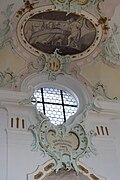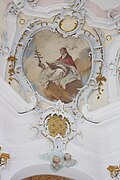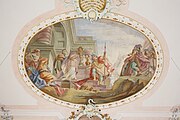Assumption of Mary (Scheppach)
The Catholic parish church of the Assumption of Mary in Scheppach , a district of the municipality of Jettingen-Scheppach in the district of Günzburg in the Bavarian administrative district of Swabia , goes back to a Gothic choir tower church . In the second half of the 18th century it was rebuilt and enlarged in the Rococo style under the direction of the builder Joseph Dossenberger . The church has a rich stucco decoration and frescoes by Franz Martin Kuen . 1924 were in the sacristy, the original choir of the Gothic church, wall paintings from the 15th / 16th centuries. Uncovered century.
history
When the Günzburg court chaplain Franz Jann took over the parish of Scheppach in 1750 , the old Gothic church was in very poor condition. Therefore, he requested the time to Further Austria belonging Oberamt Gunzburg , the construction of the church. The tithe lords were supposed to pay for the costs , of which the House of Habsburg , the taverns of Stauffenberg , the cathedral chapter of Augsburg and the lords of Freyberg-Eisenberg zu Haldenwang were the most important. In 1766 the master builder of the Augustinian Canons of Wettenhausen was commissioned to build the new church. In 1768 the old nave was demolished and the new nave was built in the same year . The following year the stucco work and the installation of the frescoes began. In 1779 the church was consecrated by Auxiliary Bishop Johann Nepomuk August Ungelter. The church, which was previously consecrated to Pope Felix II and the martyrs Simplicius, Faustinus and Beatrix , now received the patronage of the Assumption .
architecture
Exterior construction
In the east rises the four-storey former choir tower with corner pilasters and arched friezes, which still comes from the Gothic previous church. The top floor, covered with a gable roof , was added in 1693 and is equipped with pinnacles and gables in the north and south.
inner space
The church is a flat roofed hall building on a rectangular ground plan, by marbled , with stucco capitals decorated pilasters is divided. The central axes form risalit-like bulges on both sides , which, like the choir, are broken through by a three-part window group with two high and one small upper window. The corners of the nave are rounded to form niches in the east.
A tailed chancel arch opens to the drawn-square choir, to a flat dome spans and another basket arch of the chancel is separated. The present choir formed the eastern half of the old Gothic nave. The original choir in the basement of the tower is now used as a sacristy. The western nave yoke occupies a double gallery with curved parapets.
Piece
The stucco work began in 1769 under the direction of Joseph Dossenberger. Other employees named are Thomas Ollenrieder, Pontian (father) and Johann Michael (son) Hoiss, Franz Hölzle and his sons Michael and Bartholomäus. The stucco mainly serves as a frame for the wall and ceiling frescoes, while the smaller pictures are surrounded by rocaille cartouches .
The stucco cartridge on the choir arch contains the inscription: serVIVnt eI DIe aC noCte In teMpLo eIVs. Apoc. VII, 15 (they serve Him day and night in his temple). The capital letters result in a chronogram with the year 1770.
Frescoes
The wall and ceiling frescoes were created by the painter Franz Martin Kuen , who came from Weissenhorn like Pastor Franz Jann . The Holy Trinity is depicted above on the central choir fresco . In the middle level, the former church patrons are represented, Pope Felix II and the martyrs Simplicius, Faustinus and Beatrix . Beatrix, who according to the legend was strangled, holds a rope in her hand. The group of people on the right includes Mary , Joseph , St. Francis of Assisi and Johannes Nepomuk . Pastor Jann and members of the congregation occupy the lower part of the picture. In the background you can see the place Scheppach with the pilgrimage church of All Saints and the parish church of the Assumption of Mary.
On the frame of the fresco the coats of arms of the four most important tithe lords are depicted, including the double-headed eagle of the House of Habsburg. The inscription under the coat of arms OFFERENTES DECIMAS SUAS FIDELITER (Faithfully donating their tithes) reminds us that the tithe lords had to finance the rebuilding of the church. The grisailles in the corners represent the four evangelists with their symbols .
The ceiling fresco above the altar is based on an episode from the Old Testament . The priest Achimelech gives David , who is on the run from King Saul , the showbreads kept in the temple .
In the center of the large nave fresco, Ecclesia , the personification of the church, is sitting in a chariot, holding a monstrance in her right hand and a cross in her left. The side scenes are reminiscent of the rescue of Emperor Maximilian I , who got into an emergency in the mountains, and of the Roman-German King Rudolf von Habsburg , who, according to a legend , is said to have given his horse to a priest to pass a torrent. The fresco bears the inscription: Martin Kuen pinxit anno 1769 (Martin Kuen painted it in 1769).
On the grisailles in the nave corners are the four Latin church fathers Augustine of Hippo (with a burning heart in his hand), Ambrosius of Milan (with a beehive at his feet), Jerome (with a lion) and Pope Gregory the Great (with the Pope's Cross ). The scene on the ceiling under the gallery depicts Jesus driving the merchants out of the temple. The frescoes on the balustrade with the depiction of the apostles were also created by Franz Martin Kuen.
Two large wall frescoes in stucco frames show the Brazen Serpent and the finding of the cross by St. Helena on the subject. The stucco cartouches on the pillars are painted with the Stations of the Cross .
Furnishing
- The stucco pulpit was created in 1768/69 based on a design by Joseph Dossenberger.
- Franz Martin Kuen created the illusionistic architectural painting of the three altars, whose altar panels he also created. The painting on the main altarpiece is dated 1769 and depicts the Assumption of Mary. The two side figures, St. Joachim and St. Anna , are executed as grisaille .
literature
- Georg Dehio : Handbook of German Art Monuments - Bavaria III - Swabia (arr.: Bruno Bushart, Georg Paula) . 2nd Edition. Deutscher Kunstverlag , Munich 1989, ISBN 3-422-03008-5 , p. 927 .
- Julius Schöttl: The parish church in Scheppach . In: Pilgrimage Allerheiligen Scheppach . Swabian art monuments, booklet 17, Anton H. Konrad Verlag, Weißenhorn 1988.
Web links
Individual evidence
Coordinates: 48 ° 24 ′ 15.1 ″ N , 10 ° 26 ′ 42.8 ″ E














